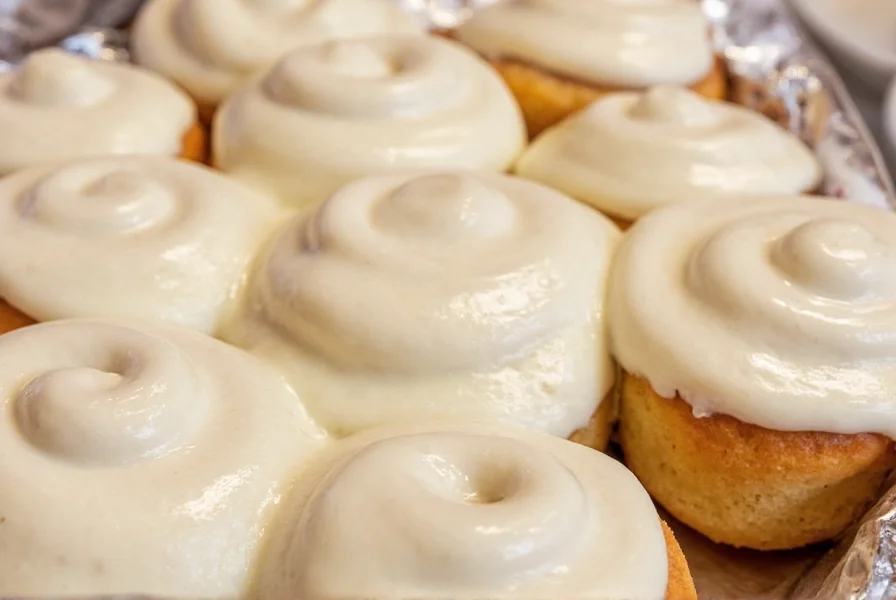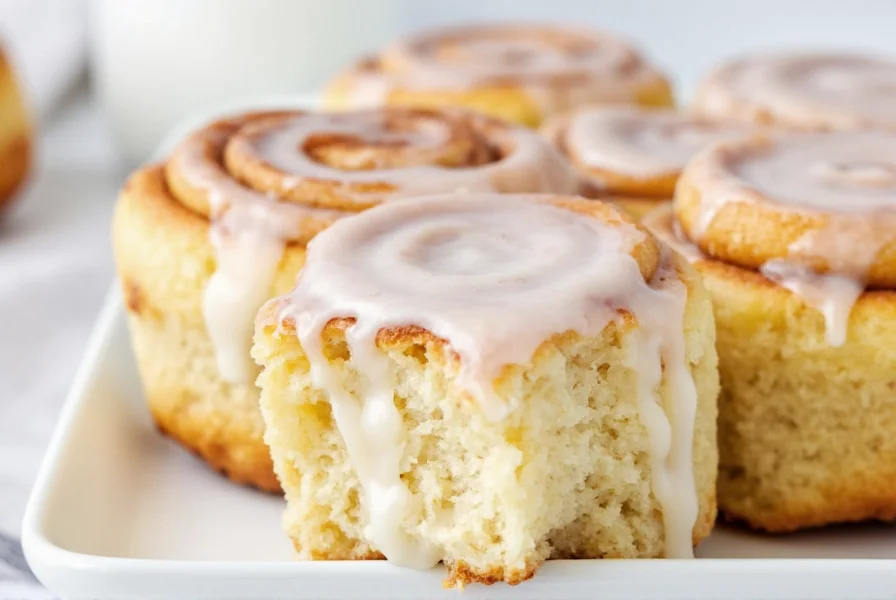Nothing completes a batch of freshly baked cinnamon rolls quite like the perfect icing. While the swirls of cinnamon-sugar filling create that signature flavor, it's the icing that transforms these pastries from good to extraordinary. Many home bakers struggle with icing that's either too runny, too thick, or lacks that professional bakery quality. The secret lies not in complexity, but in understanding the science behind the simple ingredients and their proper ratios.
Essential Ingredients and Their Roles
Understanding what each component contributes to your easy cinnamon roll icing recipe ensures consistent results every time. Unlike cake frosting that needs to hold stiff peaks, cinnamon roll icing should have a delicate balance—thick enough to cling to the rolls but fluid enough to create that beautiful drizzle effect.
| Ingredient | Function | Pro Tips |
|---|---|---|
| Powdered Sugar (Confectioners' Sugar) | Provides sweetness and structure | Sift before using to eliminate lumps; contains cornstarch which helps stabilize the icing |
| Milk or Cream | Liquid component for proper consistency | Use room temperature; whole milk creates richer texture than skim |
| Vanilla Extract | Flavor enhancer | Use pure extract, not imitation, for authentic flavor |
| Salt | Balances sweetness | Just a pinch—don't skip this for professional-quality results |
Step-by-Step Icing Preparation
Follow these precise steps for the best icing for homemade cinnamon rolls that rivals bakery quality:
- Prepare your workspace: Have all ingredients at room temperature. Cold ingredients won't blend properly and may cause the icing to seize.
- Sift the powdered sugar: This critical step removes lumps and incorporates air, creating a smoother texture. Measure first, then sift.
- Combine ingredients: In a medium bowl, whisk together 2 cups sifted powdered sugar, 2 tablespoons milk or cream, 1 teaspoon vanilla extract, and a pinch of salt.
- Adjust consistency: For thicker icing (ideal for drizzling), use 1½ tablespoons liquid. For thinner icing (better for soaking into warm rolls), add up to 3 tablespoons liquid.
- Mix thoroughly: Whisk for 1-2 minutes until completely smooth and glossy. Properly mixed icing should fall from the whisk in ribbons that hold their shape briefly before melting back into the mixture.
- Apply immediately: Pour over warm (not hot) cinnamon rolls for optimal absorption and presentation.

Cream Cheese Icing Variation
For those seeking how to make cream cheese icing for cinnamon rolls, this bakery-style variation adds richness without overwhelming the delicate cinnamon flavor:
- 2 ounces (¼ cup) full-fat cream cheese, softened to room temperature
- 2 tablespoons unsalted butter, softened
- 2 cups sifted powdered sugar
- 1-2 tablespoons milk or cream
- 1 teaspoon vanilla extract
- Pinch of salt
Cream the softened cream cheese and butter together until completely smooth and no lumps remain. Gradually add sifted powdered sugar, then liquid and flavorings. This version requires more careful temperature control—ingredients that are too cold won't blend properly, while those that are too warm will create a runny icing.
Troubleshooting Common Icing Problems
Even with this simple homemade cinnamon roll topping, issues can arise. Here's how to fix them:
Icing Too Thin
Add sifted powdered sugar, 1 tablespoon at a time, until desired consistency returns. Avoid adding more liquid once you've reached the proper thickness. For immediate correction, place the bowl over ice water while whisking gently.
Icing Too Thick
Add liquid in ½ teaspoon increments. Milk works best for traditional icing, while cream provides richer texture. For cream cheese icing, use a small amount of the liquid ingredient already in your recipe rather than adding new components.
Icing Separating or Curdling
This usually happens when ingredients are at different temperatures. Return the mixture to room temperature gradually—don't microwave. For cream cheese icing, ensure all ingredients are properly softened before beginning.
Lack of Flavor Balance
If your cinnamon roll glaze vs icing seems one-dimensional, try these adjustments:
- Add a tiny pinch more salt to enhance sweetness
- Replace 1 tablespoon milk with citrus zest (orange works particularly well with cinnamon)
- Include ¼ teaspoon cinnamon in the icing for layered flavor
- Use clear vanilla extract to maintain pure white color
Advanced Techniques for Professional Results
Take your perfect consistency for cinnamon roll frosting to the next level with these pro tips:
- Temperature matters: Apply icing to rolls that are warm (about 120°F/50°C), not hot. Too hot causes icing to melt through; too cold prevents proper absorption.
- Double-layer method: For bakery-style presentation, apply a thin first layer to seal in moisture, let set for 5 minutes, then add a second decorative layer.
- Consistency testing: Dip a spoon in the icing and draw a line across the surface—the line should hold for 10-15 seconds before disappearing.
- Storage wisdom: Icing hardens as it dries. If making ahead, cover surface directly with plastic wrap to prevent crusting.
Variations to Suit Every Preference
Customize your icing for different dietary needs and flavor preferences while maintaining that essential troubleshooting cinnamon roll icing problems foundation:
Vegan Cinnamon Roll Icing
Replace dairy milk with unsweetened almond or oat milk. For cream cheese version, use high-quality vegan cream cheese alternative. Add ½ teaspoon lemon juice to help mimic the tang of dairy cream cheese.
Sugar-Free Option
Use powdered erythritol or monk fruit sweetener blend designed for 1:1 substitution with powdered sugar. Add 1 teaspoon cornstarch to help with texture, as sugar substitutes lack the binding properties of real sugar.
Flavor Infusions
Elevate your basic recipe with these complementary flavors:
- Maple: Replace milk with pure maple syrup (reduce to 1½ tablespoons)
- Lemon: Add 1 tablespoon fresh lemon juice and zest of ½ lemon
- Bourbon: Substitute 1 tablespoon milk with bourbon for adult-friendly version
- Almond: Replace half the vanilla with almond extract (use sparingly—it's potent!)
Storage and Serving Guidance
Proper handling ensures your icing maintains its ideal texture and appearance:
- Store iced rolls covered at room temperature for up to 24 hours
- Refrigerate for longer storage (up to 3 days), but bring to room temperature before serving
- Never freeze iced rolls—the icing will separate and become grainy
- For best presentation, apply icing no more than 30 minutes before serving
Frequently Asked Questions
What's the difference between cinnamon roll glaze and icing?
Glaze is thinner and soaks into the pastry, typically made with powdered sugar and liquid only. Icing is thicker with added fat (like butter or cream cheese) for a richer texture that sits on top of the rolls. Glaze sets harder while icing remains slightly soft.
Why does my cinnamon roll icing get hard?
Icing hardens as the liquid evaporates. This happens when rolls are too cool when icing is applied, when too much powdered sugar is used, or when left uncovered. To prevent hardening, apply icing to warm rolls and store covered with plastic wrap touching the icing surface.
Can I make cinnamon roll icing ahead of time?
Yes, but with precautions. Store in an airtight container with plastic wrap pressed directly on the surface to prevent crusting. Refrigerate for up to 3 days. Before using, bring to room temperature and whisk gently—add tiny amounts of liquid if needed to restore proper consistency.
How do I fix grainy cinnamon roll icing?
Graininess usually comes from lumpy powdered sugar or improper mixing. Sift your sugar before using and whisk thoroughly for 1-2 minutes. If already grainy, add ½ teaspoon liquid and whisk over a bowl of warm water (not hot) to help dissolve sugar crystals.
Why use powdered sugar instead of regular sugar in icing?
Powdered sugar contains cornstarch which helps stabilize the icing and creates a smooth texture. Its fine particles dissolve instantly, creating a silky consistency that granulated sugar can't achieve without heating. Regular sugar would leave gritty texture and wouldn't create the proper thick-but-pourable consistency needed for cinnamon roll topping.











 浙公网安备
33010002000092号
浙公网安备
33010002000092号 浙B2-20120091-4
浙B2-20120091-4